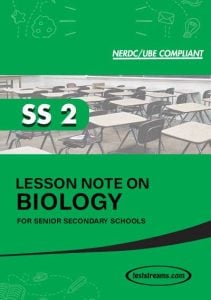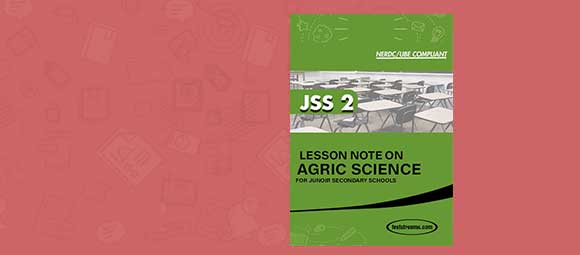This BIOLOGY Lesson Note was pulled from our book (Lesson Note on BIOLOGY for SS2 MS-WORD); Compiled to serve as reference material to help teachers draw out their lesson plan easier, saving you valuable time to focus on the core job of teaching.
This BIOLOGY Lesson Note Covers The Following Topics
- The Cell
- The Cell Structure
- The Cell and Its Environment
- Properties and Functions of The
- Cell
- Cellular Respiration
- Growth
- Irritability/Cell Reactions to Its
- Environment
- Reproduction
- Sexual Reproduction
- Reproductive Health
- Excretion
- Components of The Mammalian Skeleton
- Tissues and Supporting Systems
- Alimentary Canal/Digestive System
- Joints
- Feeding Habits
- Feeding in Amoeba, Hydra and Man
- Transport Systems
- Circulatory System in Mammals
- Mechanism of Transport in Higher Plants
- Respiratory Systems
- Mechanism of Respiratory System
- Aquatic Habitat
- Estuarine Habitats
- Fresh Water Habitats
- Terrestrial Habitats
- Forest Habitats
- Grassland or Savanna Habitats
- Ecology of Populations
- Food Shortage
Sample note
Week 1
Topic: What is a Cell?
The cell was discovered by Robert Hooke in 1665, who named the biological unit for its resemblance to cells inhabited by Christian monks in a monastery. Cell theory, first developed in 1839 by Matthias Jakob Schleiden and Theodor Schwann, states that all organisms are composed of one or more cells, that cells are the fundamental unit of structure and function in all living organisms, that all cells come from preexisting cells, and that all cells contain the hereditary information necessary for regulating cell functions and for transmitting information to the next generation of cells.
Cell can be defined as the structural and functional unit of life. It could also be describe as the simplest and basic unit of life in which are living organism are made of cells. The cell (from Latin cella, meaning “small room”) is the basic structural, functional, and biological unit of all known living organisms. A cell is the smallest unit of life that can replicate independently, and cells are often called the “building blocks of life”. The study of cells is called cell biology. A cell is the smallest unit of life that can replicate independently, and cells are often called the “building blocks of life”. The study of cells is called cell biology.
Cells consist of cytoplasm enclosed within a membrane, which contains many biomolecules such as proteins and nucleic acids. Organisms can be classified as unicellular (consisting of a single cell; including bacteria) or multicellular (including plants and animals). While the number of cells in plants and animals varies from species to species, humans contain more than 10 trillion (1012) cells. Most plant and animal cells are visible only under a microscope, with dimensions between 1 and 100 micrometres.
Classification of Living Organism Based on the Number of Cells
This Includes
- Unicellular Organism:These are organisms which consist of only one cell e.g. Amoeba, Paramecium.
- Multi-cellular Organism:These are organisms which consist of two or many cells e.g. flowering plant, Bird, Hydra.
History of Cell
Many scientist have contributed to the distribution of history of cell which are listed below;
- Robert Hooke:He is regarded as the father of cell. He was the first human being to discover the honey comb structure of the cell in 1665. In his book, Micrographic, he described his observation of a slice of a cork of an oak tree. He established that the cork is made up of thin components or rooms which he later named the components of cells.
- Felix Dujardin:He was a French biologist in 1835, which he discovered that the cell was made up of living substance. He however named the living substance protoplasm.
- Matthias Schledien:He is also a German botanist in 1838 revealed that the bodies of plants are made of cells which were described as units of life.
- Theodore Schwann:He was also a German zoologist in 1839; He discovered that the bodies of all animals are composed of cells.
- Rudolf Von Virchow:He was also a German biologist in 1855, concluded in his research that all cells come from previously existing cells.
Forms In Which Living Cells Exist
These include;
- As Independent or Single and Free Living Organism: This means that organism that possesses only one cell and is capable of living freely on their own. e.g. Amoeba, Paramecium.
- As a Colony: This means that some organism are made of many similar cells which are joined or massed together but they cannot be differentiated from each other .e .g Volvox, Pandorina, etc.
- As a Filament: This simply that certain cells are organised into filaments. Each cells functions as an independent living cell. E.g. Spirogyra, Zygnema.
- Cells as Part of a Living Organism: This means that in a multi-cellular organism, a group of numerous, similar cells are arranged together to perform specific functions and this is called a tissue. A group of similar tissue forming a layer in an organism which performs a specific function is called an organ. A group of organs which work together to perform specific functions is called a system.
| Colonial Organism | Filamentous Organism |
| 1. There is absence of intercellular wall. | There is presence intercellular wall. |
| 2. The identical cells forms a mass. | The identical cells form end to end arrangement in linear form. |

Get the complete Lesson Note with more content at very affordable price.Lesson Note on BIOLOGY for SS2 MS-WORD- PDF
![]()




